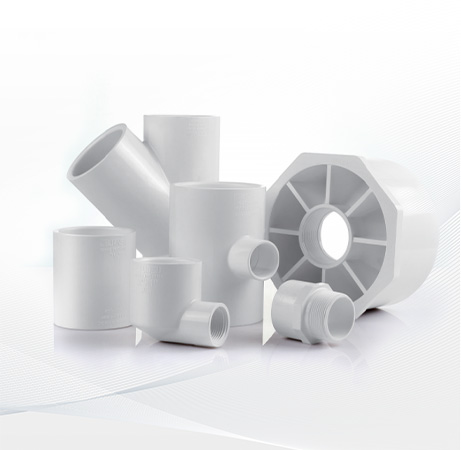PVC DWV fittings are for drainage, waste, and vent applications under erratic load and pressure conditions. They maintain interior diameters that decrease friction and turbulence in fluid flow. They resist scale buildup, temperature swings, and chemical abrasion. Selection assures pipe alignment, discharge, and code compliance. In industrial settings, the right fittings handle aggressive substances and thermal expansion without leaks. In residential systems, they help avert backflow, odors, and structural damage with precise venting and discharge rates. Even minor misalignments can trigger costly failures and remediation without proper fittings.

PVC DWV fittings use gravity-driven flow and conform to ASTM D2665 for drain, waste, and vent uses. They have smooth inner walls that cut friction and help solids travel down the line. They also show a low thermal expansion coefficient (3.38 × 10⁻⁵ in/in/°F) to keep dimensional stability in high-humidity and high-temperature environments.[1] PVC DWV plumbing fittings may have sweep angles that adjust fluid flow velocity and turbulence, which lessens blockages over time. It impacts fixture venting, so negative air pressure is relieved across branch lines.
Elbows with long-radius bends, sanitary tees, and wyes connect sloped runs and promote laminar flow through building layouts. Long-turn elbows offset changes in pipe direction without abrupt flow disturbances. Sanitary tees incorporate a sweeping inlet. They prevent backflow and facilitate transitions from branch drains into main stacks. Wyes help split or combine flow paths and lower pressure buildup in horizontal sections. Double fixture tees also offer symmetrical ports for back-to-back fixture connections. They keep internal fluid trajectories clean and turbulence-free.
PVC DWV fittings tackle corrosive household effluents and acidic discharge from appliances without chemical degradation. Their stable polymer matrix resists scaling and microbial growth. It lengthens service life and lowers upkeep demands. Their low material weight simplifies overhead work. It helps crews navigate tight spaces and secure connections with less strain. Thermal conductivity is low. Hence, condensation risks are decreased when vent lines pass through unconditioned zones. Additionally, PVC DWV fittings cost less than many metallic alternatives when you consider lower labor time to cut and align large-diameter runs.
At LESSO America, we utilize over 30 years of experience producing high-quality pipe fittings for plumbing and irrigation applications. Our product range includes PVC DWV fittings, ABS DWV fittings, and other SDR35 sewer fittings. Unquestionably, they all fulfil the needs of our clients across industries. Our commitment to sustainability and quality guarantees that our products satisfy industry standards and promote environmental well-being.
Our PVC DWV fittings are manufactured using injection molding techniques for quality and durability. They are made from high-quality PVC materials and encompass tees, adapters, elbows, crosses, couplings, bushings, caps, plugs, traps, and bends. Our designs have easy-fasten mechanisms that simplify installation while addressing durability standards through testing. Once installed, a LESSO plumbing system will serve dependably for years with negligible maintenance. No doubt, it helps save time and cost over the life of your project.
There are different types of PVC DWV fittings, including tee, ell, and more. You should learn more about their functionalities and choose which one is suitable for your project.
PVC DWV fittings must match the fixture load requirements. A 3-inch drain might be used for typical toilet lines. Certain commercial drops may need 4-inch or larger fittings to avoid backflow at peak flow rates.
PVC DWV fittings behave differently under standard or combination waste-and-vent systems. They need transition couplings for cast iron tie-ins. It confirms code-compliant expansions and offsets in multi-level installs.
PVC DWV fittings should meet ASTM standards for dimensions. Look for uniform wall thickness, the least voids, and a high cell classification rating for lower micro-cracking in high-temperature discharge lines.
Established producers have tighter dimensional tolerances for PVC DWV fittings. It averts alignment issues, helps resist UV-induced brittleness, and keeps chemical resistance across fixture points.
PVC DWV pipe fittings with ideal material specs may cost more initially. Yet, they curtail unexpected replacements and code violations while maintaining flow performance in arduous, high-usage environments over time.
At LESSO America, we offer a range of DWV fittings PVC, including but not limited to tees, adapters, elbows, crosses, couplings, bushings, caps, plugs, traps, and unions. All are made from high-quality PVC materials. In addition, our products comply with ASTM standards for reliability for your plumbing projects. Contact us and explore our offerings to find the right solutions for your needs.
[1] Expansion Fittings for PVC Rigid Nonmetallic Conduit. Available at: https://www.nema.org/docs/default-source/standards-document-library/nema-prp-4-2009-(r2016)-watermarked.pdf?sfvrsn=79bb0669_2#:~:text=These%20temperature%20changes%20affect%20Polyvinyl,six%20times%20that%20of%20steel.(Accessed: January 15)
TOP